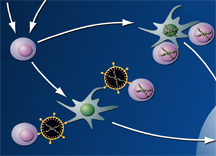

New Research Identifies a Novel Receptor and Potential Target to Prevent the Sexual Transmission of HIV-1
By Eric Sauter
Despite massive global efforts and the widespread availability of preventive measures, heterosexual intercourse remains the most common infection route of HIV—some 80 percent of all new infections. But the precise sequence of events that takes place from the moment the virus hits the mucosal wall until systemic HIV-1 infection is established remains a relative mystery.
Now Scripps Research Institute scientists, joined by colleagues from Belgium and the Netherlands, have discovered that receptors on dendritic cells may be deeply involved in the transmission of the deadly virus and, quite possibly, the ideal targets to help prevent it. A new study identified the syndecan-3 receptor, a major HIV-1 attachment receptor on the surface of dendritic cells, as key to the transmission process.
The study was published in a special online edition of the Proceedings of the National Academy of Sciences on November 26, 2007, and will appear in the December 4 print edition of the journal.
Syndecan-3 not only stabilizes the captured virus, it also enhances dendritic cell infection and promotes transmission of HIV-1 to T-cells in vitro, the study said.
In addition, the study demonstrated that neutralizing syndecan-3 and a second dendritic cell receptor called dendritic cell SIGN or DC-SIGN completely short-circuited the capture and transmission of HIV-1. Neutralizing the syndecan-3 receptor alone only partially inhibited HIV-1 transmission.
"Because HIV-1 exploits both syndecan-3 and DC-SIGN to help its transmission," said Philippe Gallay, a Scripps Research associate professor who led the study, "it's possible that by developing a microbicide that targeted both, we could prevent transmission of the virus. This would be very important in the developing world because micobicides are less expensive to produce, reasonably effective, and easy to store and use."
Of Trojan Horses
Dendritic cells play a critical role in the human immune system, presenting foreign antigens to T-cells in the lymph nodes and helping to shape the body's immune response. HIV-1 takes full advantage of this pathway.
Since cell-free viruses like HIV-1 have trouble crossing genital epithelial cells without surface lesions, they use dendritic cells and, quite possibly, Langerhans cells as molecular Trojan horses to penetrate the normally impermeable epithelium.
"I am convinced that syndecan-3 and DC-SIGN use different pathways, and that HIV-1 exploits these different pathways to maximize its chances of entering the body," Gallay said. "Its ability to exploit so many receptors is really quite amazing, a nearly perfect example of the power of evolution."
The syndecan-3 and DC-SIGN receptors are fairly new discoveries, Gallay noted. DC-SIGN was discovered in 2000 by Teunis Geijtenbeek, one of the co-authors of the current study.
In the new paper, the authors reported that once HIV-1 bound to a receptor, the virus remained highly infectious for more than four days, whereas free HIV-1 (unbound to a receptor) looses its infectivity in less than a day. In fact, both syndecan-3 and DC-SIGN were involved in preserving and enhancing the infection strength of HIV-1.
The fact that syndecan-3 is expressed by dendritic cells is striking, the study noted, since its expression has been described previously only in the nervous system. It is possible that binding of HIV-1 to syndecan-3 might affect dendritic cell function, the study added, and that the receptor might influence viral transmission in vivo.
"We showed that syndecan-3 is localized in the dendrite-like arms—which project outward like branches—of cervical dendritic cells, while DC-SIGN is localized at the center of these cells," Gallay said. "This is reminiscent of the localization of syndecan-2 in the dendritic branches of neurons. Our findings suggest that HIV-1 then uses syndecan-3 to breach the epithelial surface."
Once HIV-1 hijacks the dendritic cells to traffic to the lymph nodes, the virus is transmitted to helper T-cells. After that, the virus begins replication, reducing the number of helper T-cells, corrupting the immune system, and transforming the lymph glands into its own viral reproduction factory.
Stopping HIV Infection
These new findings highlight the potential of at least one of the current trends in HIV/AIDS—the search for novel ways to stop the virus before it enters the body. Current anti-viral treatments are aimed at blocking viral replication in T-cells.
Microbicides—creams, gels, or films—can be applied inside the vagina to protect against sexually transmitted infections. According to the World Health Organization (WHO), a successful HIV microbicide could have a significant impact on the global HIV/AIDS epidemic.
One recent study by the London School of Hygiene and Tropical Medicine indicated that the introduction in 73 lower-income countries of a microbicide that reduced the risk of infection by 40 per cent (with only a 30 percent coverage) would prevent nearly six million infections over three years in men, women, and children. In addition, this would reduce health care costs (excluding the cost of antiretroviral therapy) by more than $3 billion.
Unfortunately, an effective HIV microbicide is not currently available.
"It's very important to develop an HIV microbicide," Gallay said, noting that the team is working on a project to develop microbides that will target syndecan-3 and DC-SIGN.
One practical advantage of developing compounds that could prevent HIV-receptor interaction is that many sexually transmitted pathogens also exploit them. Blocking these interactions could have the benefit of preventing other sexually transmitted diseases while providing a new way to assess the role of these cells in HIV transmission.
"Any microbicide that targets virus capture by dendritic cells should act on both classes of receptors," Gallay said. "Unfortunately, some recent clinical trial failures show that this is not a simple process. Right now, we need to develop compounds that specifically prevent HIV-1-syndecan-3 interaction in order to more thoroughly examine the role of syndecan-3 in HIV-1 capture and transfer by dendritic cells."
Other authors of the study, Syndecan-3 Is A Dendritic Cell-Specific Attachment Receptor For HIV-1, are Michael Bobardt and Udayan Chatterji of The Scripps Research Institute; Lot de Witte and Teunis Geijtenbeek of the VU University Medical Center, The Netherlands; and Gisèle Degeest and Guido David of the University of Leuven and Flanders Interuniversity Institute for Biotechnology, Belgium. For an abstract of the article, see PNAS at http://www.pnas.org/cgi/content/abstract/0703747104v1.
The study was supported by the U.S. Public Health Service and by the Dutch Scientific Research program and the Dr. Saal van Zwanenbergstichting Fellowship.
Send comments to: mikaono[at]scripps.edu

Associate Professor Philippe Gallay's lab focuses on the early steps of the HIV life cycle.

"I am convinced that syndecan-3 and DC-SIGN use different pathways, and that HIV-1 exploits these different pathways to maximize its chances of entering the body," says Philippe Gallay. Click for image details.
